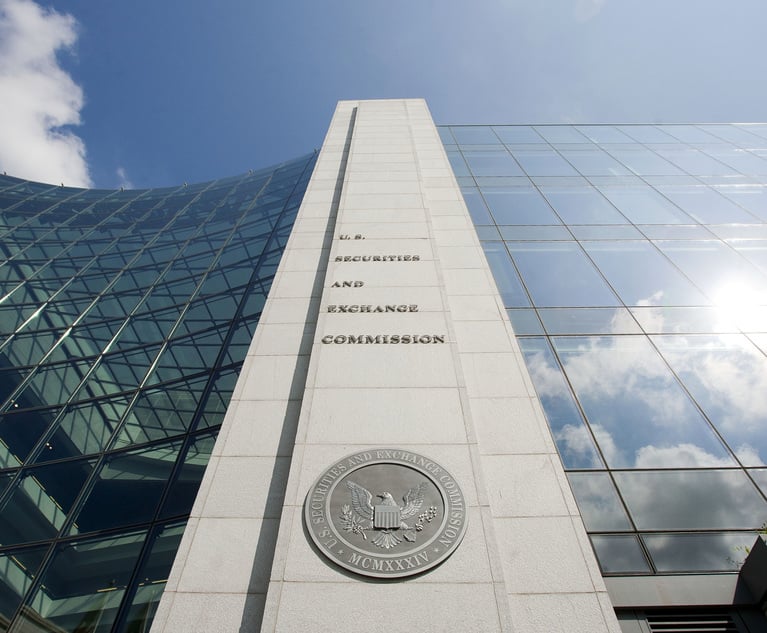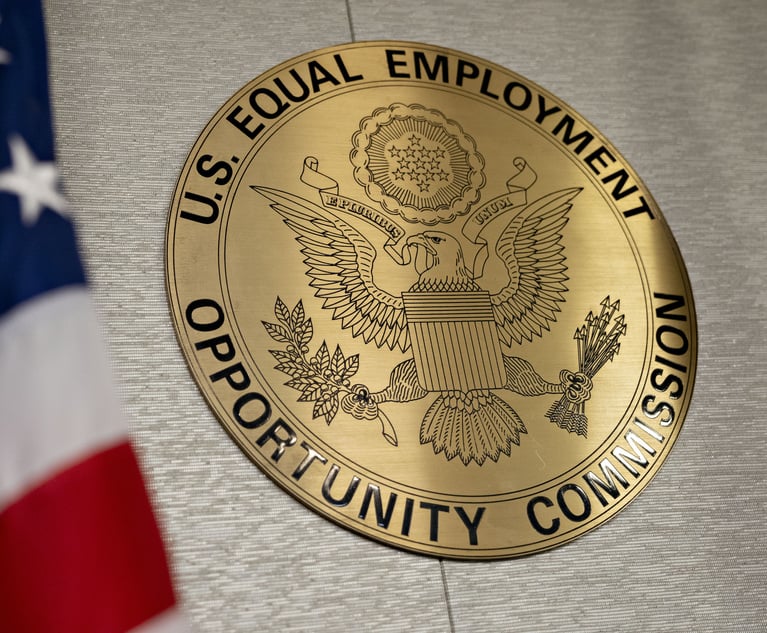Software Copyrights Take A Backseat To Patents
IP Consultant Wants Software Copyrights Declared Unconstitutional
March 31, 2005 at 07:00 PM
7 minute read
Gregory Aharonian has struck again. A well-known IP consultant and author of a widely read newsletter on patents, “PatNews,” Aharonian has been attacking the legitimacy of many software and business-method patents for years. Now this IP gadfly is taking aim at copyrights.
On Dec. 7, 2004, Aharonian, who is developing a proprietary database program, filed a declaratory judgment action asking the San Francisco federal court to declare software copyrights unconstitutional. He believes it's difficult, if not impossible, to determine which aspects of a software program a copyright protects, pointing out that he could be prosecuted for criminal copyright infringement for building his database program.
Many experts believe it will be tough for Aharonian to win. But if he does succeed in killing software copyrights, how much difference would it make to businesses? Could companies turn to an alternative form of IP protection?
More and more companies are seeking patents on their software. In the 10 years from 1993 to 2003, the number of software patents granted annually shot up approximately 400 percent, from 4,938 to 19,638. And this despite the obvious disadvantages of patent protection: it's difficult to obtain, costly and lasts for only 20 years from filing–approximately one-tenth of the period a copyright provides. Nonetheless, patents have become a crucial method for protecting rights in software.
“Software patents are becoming a normal part of doing business,” says Mark Radcliffe, an IP law expert in the Palo Alto office of DLA Piper Rudnick Gray Cary. “If you are not thinking about getting these patents, you are putting yourself at risk.”
Getting It Down Pat
Companies have traditionally relied on copyrights to protect their IP software from infringement. But the extent of such protection is limited.
One major reason is that the copyright statute doesn't protect any “idea, procedure, process, system [or] method of operation.” The courts have interpreted this provision of 17 U.S.C. ?? 1/2 102(b) to exclude protection for all utilitarian aspects of software.
Suppose, for instance, your company developed an original database program. A copyright wouldn't protect the software's main attraction–the code that allows the program to provide useful functions. It only would protect the nonutilitarian aspects of a program, such as the unique design of the program icons. So a competitor could reverse engineer your program, copy the code for all the utilitarian features, add some new code that affects the aesthetic look and feel of the program–and voil?? 1/2 , no infringement.
A related shortcoming of copyright protection is that, since the Supreme Court's 1879 seminal decision in Baker v. Selden, the courts have repeatedly declared that copyright protects only an author's “expression” of an idea, not the idea itself. For instance, while copyright would forbid someone from making a mural that is almost identical to Picasso's Guernica, the law wouldn't prevent a painter from creating a mural that uses expressionistic techniques to show the horrors of war.
Unfortunately, it is extremely difficult to apply these two restrictions of copyright to software. Which parts of a program are utilitarian? Which parts are protectable expression?
In his suit, Aharonian claims there's no good way to draw these distinctions, and that the courts have been all over the map in determining which aspects of software are protected. Thus, there is no way for him to know if his new business product will run afoul of copyright law.
Aharonian's motivation for filing suit is personal. He is creating a database system that analyzes the quality of software patents and tries to distinguish idea from expression in software. This would require his database to contain all or part of many computer programs. But because the scope of software copyright is so vague, Aharonian can't determine which portions of pre-existing software he can legally copy into the database. Should he guess wrong, he could be criminally prosecuted for copyright infringement.
This threat of criminal prosecution, he claims, violates the due process clause of the Constitution. The Supreme Court in 1999 ruled in City of Chicago v. Morales that “a law fails to meet the requirements of the Due Process Clause if it is so vague and standardless that it leaves the public uncertain as to the conduct it prohibits.” Thus, Aharonian has asked the district court to declare software copyrights unconstitutional.
Patently Obvious
Most likely, the courts won't be too receptive to Aharonian's argument, but it does raise some real issues about software copyrights.
“It is hard to tease out what is protectable,” says Walter Scott, a partner in the IP practice group at Alston & Bird. “With software, it is hard to say what is an idea and what is the expression of an idea. This problem is compounded because a good computer program is like a cog in a machine that makes something–so it starts to look like a 'process' that is excluded from copyright.”
As a result, companies have been searching for better ways to protect software. And they are beginning to turn to patents.
“Until about 15 years ago, people didn't believe software could be patented,” Radcliffe says. “Five years ago, it was still controversial. Now, most software companies are getting patents for offensive and defensive purposes.”
Obtaining such protection isn't easy or cheap. Prosecuting a patent application can take months or even years. And the cost for an average software patent runs between $10,000 and $20,000. By contrast, registering a copyright can take less than a day and can cost as little as $530 dollars in registration fees plus legal expenses.
A patent, however, can protect the key utilitarian features of the software–the underlying functions it performs, as well as the novel and useful features in its interface. These are exactly the elements that copyright can't protect.
A patent also offers a much greater degree of protection. While a copyright only protects against unauthorized copying, a patent prohibits competitors from making substantially similar products. A patent protects the idea and any implementation of the idea. “It is much more difficult to reverse engineer around it,” Radcliffe says.
Yet software patents will continue to remain the exception, not the rule, according to Steven Lundberg, an attorney in Minneapolis-based Schwegman, Lundberg, Woessner & Kluth and the lead author of the book, “Electronic and Software Patents: Law and Practice.”
“Ninety-five percent of code wouldn't define a patentable process,” he says. “Any given program might have a few patentable inventions, but you couldn't patent the literal code sequences.”
Without copyright protection, Lundberg concludes, “the vast majority of programs would be exposed to ready piracy.”
The Long Run
Not all experts think software copyrights are so important. If these copyrights suddenly vanished, most companies wouldn't care, according to Scott, because the businesses would use contracts to protect their rights in software. End-user license agreements (which usually require users to click “OK” to use the program) already set limits on copying and reverse engineering software programs, and these agreements would still be enforced, regardless of what happened in Aharonian's suit.
Aharonian will have a very tough time winning this legal battle, according to most experts. “He has to overcome 20 years of court precedents that have held that software is copyrightable,” Radcliffe says.
For the foreseeable future companies can use a variety of methods to protect their rights in software–and courts will have to keep struggling to determine what copyrights actually protect.
“It is difficult … to distinguish between ideas and expression in software,” says Michael Sandonato, an IP attorney in the New York office of Fitzpatrick, Cella, Harper, and Scinto, “but many things in law are difficult.”
This content has been archived. It is available through our partners, LexisNexis® and Bloomberg Law.
To view this content, please continue to their sites.
Not a Lexis Subscriber?
Subscribe Now
Not a Bloomberg Law Subscriber?
Subscribe Now
NOT FOR REPRINT
© 2025 ALM Global, LLC, All Rights Reserved. Request academic re-use from www.copyright.com. All other uses, submit a request to [email protected]. For more information visit Asset & Logo Licensing.
You Might Like
View All

Trending Stories
- 1Munger, Gibson Dunn Billed $63 Million to Snap in 2024
- 2January Petitions Press High Court on Guns, Birth Certificate Sex Classifications
- 3'A Waste of Your Time': Practice Tips From Judges in the Oakland Federal Courthouse
- 4Judge Extends Tom Girardi's Time in Prison Medical Facility to Feb. 20
- 5Supreme Court Denies Trump's Request to Pause Pending Environmental Cases
Who Got The Work
J. Brugh Lower of Gibbons has entered an appearance for industrial equipment supplier Devco Corporation in a pending trademark infringement lawsuit. The suit, accusing the defendant of selling knock-off Graco products, was filed Dec. 18 in New Jersey District Court by Rivkin Radler on behalf of Graco Inc. and Graco Minnesota. The case, assigned to U.S. District Judge Zahid N. Quraishi, is 3:24-cv-11294, Graco Inc. et al v. Devco Corporation.
Who Got The Work
Rebecca Maller-Stein and Kent A. Yalowitz of Arnold & Porter Kaye Scholer have entered their appearances for Hanaco Venture Capital and its executives, Lior Prosor and David Frankel, in a pending securities lawsuit. The action, filed on Dec. 24 in New York Southern District Court by Zell, Aron & Co. on behalf of Goldeneye Advisors, accuses the defendants of negligently and fraudulently managing the plaintiff's $1 million investment. The case, assigned to U.S. District Judge Vernon S. Broderick, is 1:24-cv-09918, Goldeneye Advisors, LLC v. Hanaco Venture Capital, Ltd. et al.
Who Got The Work
Attorneys from A&O Shearman has stepped in as defense counsel for Toronto-Dominion Bank and other defendants in a pending securities class action. The suit, filed Dec. 11 in New York Southern District Court by Bleichmar Fonti & Auld, accuses the defendants of concealing the bank's 'pervasive' deficiencies in regards to its compliance with the Bank Secrecy Act and the quality of its anti-money laundering controls. The case, assigned to U.S. District Judge Arun Subramanian, is 1:24-cv-09445, Gonzalez v. The Toronto-Dominion Bank et al.
Who Got The Work
Crown Castle International, a Pennsylvania company providing shared communications infrastructure, has turned to Luke D. Wolf of Gordon Rees Scully Mansukhani to fend off a pending breach-of-contract lawsuit. The court action, filed Nov. 25 in Michigan Eastern District Court by Hooper Hathaway PC on behalf of The Town Residences LLC, accuses Crown Castle of failing to transfer approximately $30,000 in utility payments from T-Mobile in breach of a roof-top lease and assignment agreement. The case, assigned to U.S. District Judge Susan K. Declercq, is 2:24-cv-13131, The Town Residences LLC v. T-Mobile US, Inc. et al.
Who Got The Work
Wilfred P. Coronato and Daniel M. Schwartz of McCarter & English have stepped in as defense counsel to Electrolux Home Products Inc. in a pending product liability lawsuit. The court action, filed Nov. 26 in New York Eastern District Court by Poulos Lopiccolo PC and Nagel Rice LLP on behalf of David Stern, alleges that the defendant's refrigerators’ drawers and shelving repeatedly break and fall apart within months after purchase. The case, assigned to U.S. District Judge Joan M. Azrack, is 2:24-cv-08204, Stern v. Electrolux Home Products, Inc.
Featured Firms
Law Offices of Gary Martin Hays & Associates, P.C.
(470) 294-1674
Law Offices of Mark E. Salomone
(857) 444-6468
Smith & Hassler
(713) 739-1250







